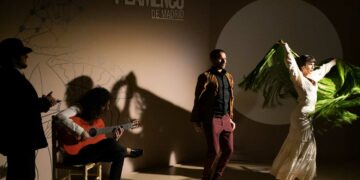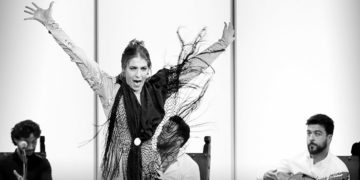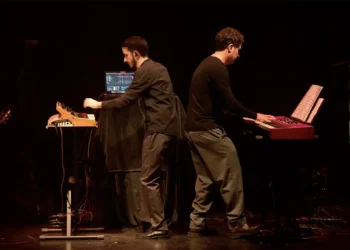|
“NI AQUÍ NI ALLÍ” |
||||||
|
Text: Manuel Moraga ERRANT SOULS “You can change your destiny, but not your roots” says an off-stage voice in the middle of the show. This is one of the running themes in “Ni Aquí ni Allí”, an original story of errant souls told through the eyes and ears of Pepa Molina who embarks on the most personal and committed work of her career. On more than one occasion we have commented the value of the series “La Otra Mirada del Flamenco” presented each year at Madrid’s Teatro Pradillo, This space gives a double opportunity: to theater-goers to be able to see an open-minded flamenco show; and to the interpreters to be able to express themselves without shackles, and even take risks with less fear. Pepa Molina from Granada takes on her artistic maturity with a show based on evocations. The idea of detachment, of the changing of one’s home turf and horizons is full of possibilities because these things affect the internal structure of a person: memories, future, uncertainty, fear, the path, nostalgia, hope… This is undoubtedly a great source to seek, find and express ideas. And that’s exactly how Pepa Molina sees it. “Without a fixed path, crossing time”…”You don’t just go places aimlessly”… These are other off-stage phrases that illustrate perfectly the underlying spirit of the show. Pepa Molina is a dancer and an actress. One moment she’s wandering around the stage, suitcase in hand, thoughts lost in space, and the next, she’s dancing siguiriyas with her heart on her sleeve. With simple but well-conceived staging, the dancer makes us all accomplices to her feelings of insecurity and uneasiness. Jesús Fernández, guest artist from Cádiz, is a prodigious dancer. He too is an excellent actor who knows how to wrap up and deliver his product in just the right way. His tanguillos are noteworthy. His feet sing, in the best sense, and his movements could not be more graceful. The very versatile Pepa Molina carries the story line through various moments in time, a pace that quickens with each dance in the form of strength the dancer knows how to dole out with elegance. She works the bata de cola artfully, making it look easy. She chose sigiuriyas for her main dance, and knew how express all the angst required by the style and the show. The closing shot was none other than “Cry me a River”, a classic jazz song she was forced to take on at first without a microphone. She’s not Ella Fitzgerald or Dinah Washington, but the piece came off as a brave curiosity. The music was also noteworthy. Luís Miguel Manzano, of the Pelao dynasty, did a fine job constructing atmosphere and transitions. Also outstanding was the singing of Roberto Llorente, in his particular style, and David Vázquez whom I confess was unknown to me and made a very good impression. And this in turn made me reflect yet again on the many flamenco artists who never quite find their niche, or don’t have the opportunity to become known. Diego Villegas on wind instruments was terrific; he seemed at times to use the flute as a percussive instrument. Truly amazing. ”No estar ni aquí ni allí…no ser” [neither here, nor there…absence of being] says the off-stage voice. An interesting proposition tackled by Pepa Molina with sincerity and talent. Let’s hope the company gets to see many airports, not as restless errant souls as seen in this work, but with the dream of individuals who are going to take their art to the world.
|






























